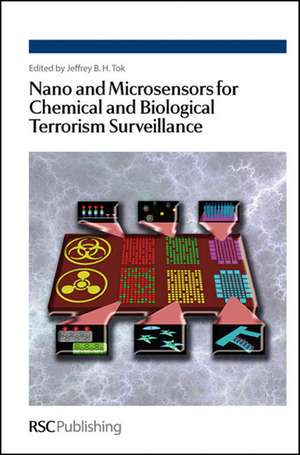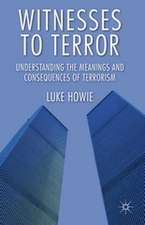Nano and Microsensors for Chemical and Biological Terrorism Surveillance
Editat de Jeffrey B. H. Token Limba Engleză Hardback – 31 aug 2008
The 9/11 attack on US soil has inadvertently heightened the need for preparation for other potential means of terrorist attack. In particular, both biological and chemical warfare have been at the top of the priority list for most governmental agencies as these reagents can be covertly prepared and disseminated to result in both widespread fear and casualty. Among many others, one primary preventive step in preparing for the above attacks is to establish a network for efficient surveillance and rapid detection such that an appropriate response to such attacks can be timely and effective. Over the years, primarily due to technological advances, both chemical and biological agents that are able to inflict mass destructions are becoming more diverse and complex. Subsequently, improvement of sensing devices for rapid and sensitive detection should also be made to keep pace with these engineered or emerging threat agents. Of particular interest, the ability to encompass advances in micro and nanofabrication techniques to enable sensing devices are especially of interest as they have been shown to offer desired advantages such as improved and enhanced functionality, increased efficiency and speed in their readout, reduction in their fabrication cost, and also reduced reagent consumption. Numerous innovative and exciting reports which took advantage of these techniques for both chemical and biological sensing have appeared over the last decade. This unique book is the only current publication that provides readers with a brief, yet concise, collection of the latest advances in chemical and biological agent detection and/or their surveillance. It compiles and gives in-depth detail on several detection schemes so that the reader can be provided with a general sense of these micro and nanoscale sensing systems and platforms. The book covers both well established and "next-generation" micro- and nano-scale sensors and/or sensing platforms. Sensors or sensing platforms covered range from the novel utilization of nanotubes, cantilevers, nano and/or microsized pores, engineered whole cell, to polymeric transistors for sensing purposes. As a result of these advances there has been a synergistic marriage of a myriad of techniques, ranging from chemical, engineering and biological, for the development of sensors, which was once traditionally thought to be reserved for the immunologists. The enabling of these new technologies will result in a much improved sensing network for the detection and surveillance of both chemical and biological warfare agents.The book also contains chapters from leading experts in the field of chemical and biological sensing platforms and will be invaluable reading for anybody in this field.
Preț: 777.86 lei
Preț vechi: 904.49 lei
-14% Nou
Puncte Express: 1167
Preț estimativ în valută:
148.85€ • 155.80$ • 123.88£
148.85€ • 155.80$ • 123.88£
Carte tipărită la comandă
Livrare economică 31 martie-14 aprilie
Preluare comenzi: 021 569.72.76
Specificații
ISBN-13: 9780854041404
ISBN-10: 0854041400
Pagini: 208
Dimensiuni: 155 x 236 x 18 mm
Greutate: 0.5 kg
Ediția:1
Editura: Royal Society Of Chemistry
ISBN-10: 0854041400
Pagini: 208
Dimensiuni: 155 x 236 x 18 mm
Greutate: 0.5 kg
Ediția:1
Editura: Royal Society Of Chemistry
Cuprins
1 - Carbon Nanotube Network for Chemical and Biological Agent Sensing; Carbon-Nanotube-Network Sensors; Introduction; Sensor Design and Fabrication; SWNT Networks; Sensor Fabrication; Electronic Transduction and Noise; Conductance; Capacitance; Electrical Noise; Gas/Vapor Detection; Gas Detection; Vapor Detection; Biological Detection; DNA-Based Detection; Antibody/Antigen-Based Detection; Aptamer-Based Detection; Summary; References;
Notă biografică
Jeffrey B-H Tok joined the Chemistry, Materials and Life Sciences Directorate, Lawrence Livermore National Laboratory in February 2004. He came to LLNL from The City University of New York (CUNY), NYC, where he was an Associate Professor of Chemistry and Biochemistry in the Graduate Center and York College of CUNY. He has been recognized with awards from American Cancer Society, the American Association for Cancer Research and the Department of Homeland Security. He has also recently served in the NIH-NIAID review panel and was selected to be an associate editor for the American Journal of Biochemistry & Biotechnology. He has previously organized a session on Gordon Research Conference of Chemical & Biological Terrorism and co-organized a symposium and tutorial in the Fall MRS 2007. Dr Tok has published approximately 30 peer-reviewed research journal articles to date and has refereed for numerous peer reviewed journals, and has also referred for numerous external grant proposals.
Textul de pe ultima copertă
The 9/11 attack on US soil has inadvertently heightened the need for preparation for other potential means of terrorist attack. In particular, both biological and chemical warfare have been at the top of the priority list for most governmental agencies as these reagents can be covertly prepared and disseminated to result in both widespread fear and casualty. Among many others, one primary preventive step in preparing for the above attacks is to establish a network for efficient surveillance and rapid detection such that an appropriate response to such attacks can be timely and effective. Over the years, primarily due to technological advances, both chemical and biological agents that are able to inflict mass destructions are becoming more diverse and complex. Subsequently, improvement of sensing devices for rapid and sensitive detection should also be made to keep pace with these engineered or emerging threat agents. Of particular interest, the ability to encompass advances in micro and nanofabrication techniques to enable sensing devices are especially of interest as they have been shown to offer desired advantages such as improved and enhanced functionality, increased efficiency and speed in their readout, reduction in their fabrication cost, and also reduced reagent consumption. Numerous innovative and exciting reports which took advantage of these techniques for both chemical and biological sensing have appeared over the last decade. This unique book is the only current publication that provides readers with a brief, yet concise, collection of the latest advances in chemical and biological agent detection and/or their surveillance. It compiles and gives in-depth detail on several detection schemes so that the reader can be provided with a general sense of these micro and nanoscale sensing systems and platforms. The book covers both well established and "next-generation" micro- and nano-scale sensors and/or sensing platforms. Sensors or sensing platforms covered range from the novel utilization of nanotubes, cantilevers, nano and/or microsized pores, engineered whole cell, to polymeric transistors for sensing purposes. As a result of these advances there has been a synergistic marriage of a myriad of techniques, ranging from chemical, engineering and biological, for the development of sensors, which was once traditionally thought to be reserved for the immunologists. The enabling of these new technologies will result in a much improved sensing network for the detection and surveillance of both chemical and biological warfare agents. The book also contains chapters from leading experts in the field of chemical and biological sensing platforms and will be invaluable reading for anybody in this field.
Descriere
A concise collection of the latest advances in chemical and biological agent detection and/or their surveillance written by leading experts in the field.

















